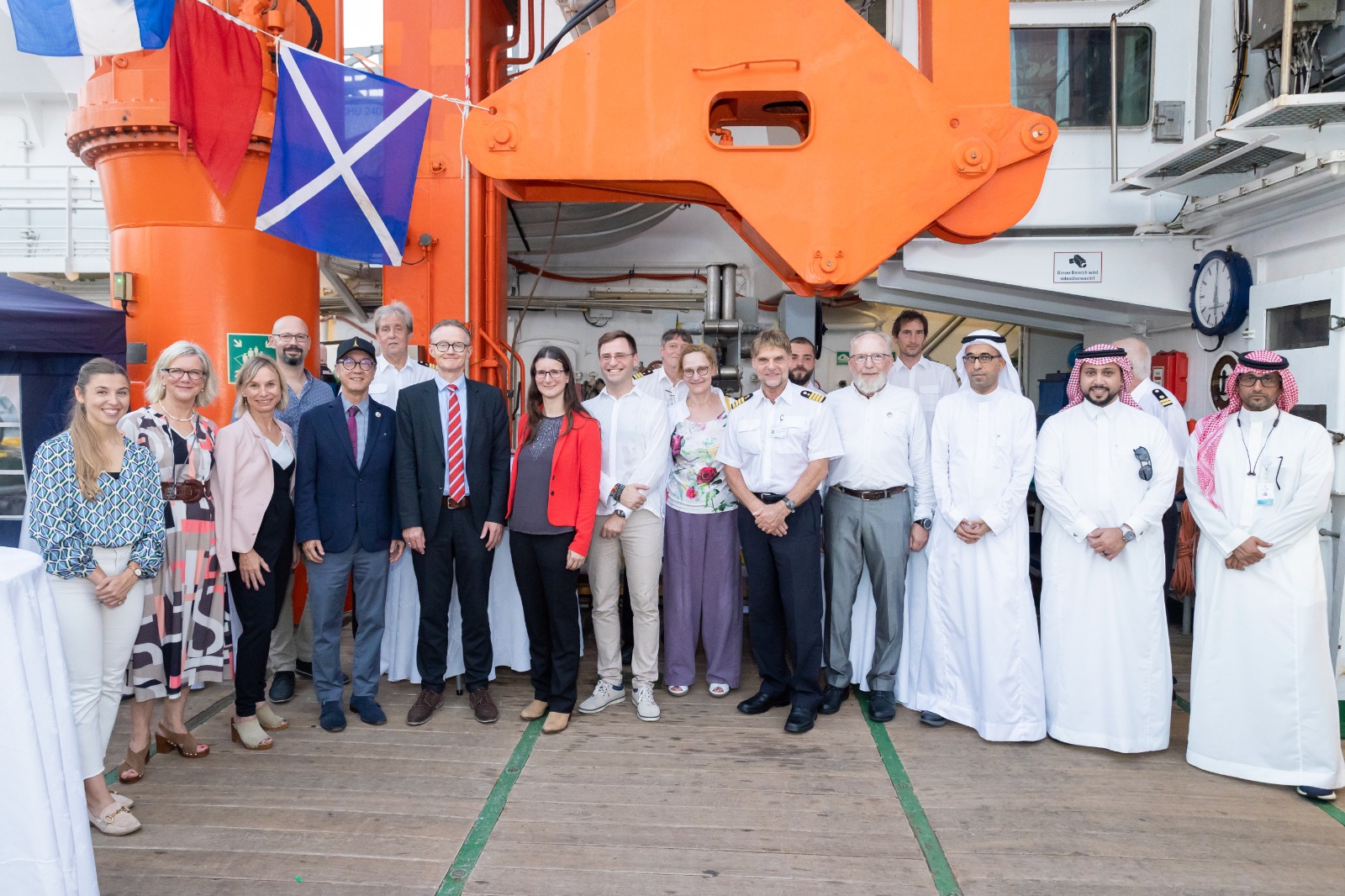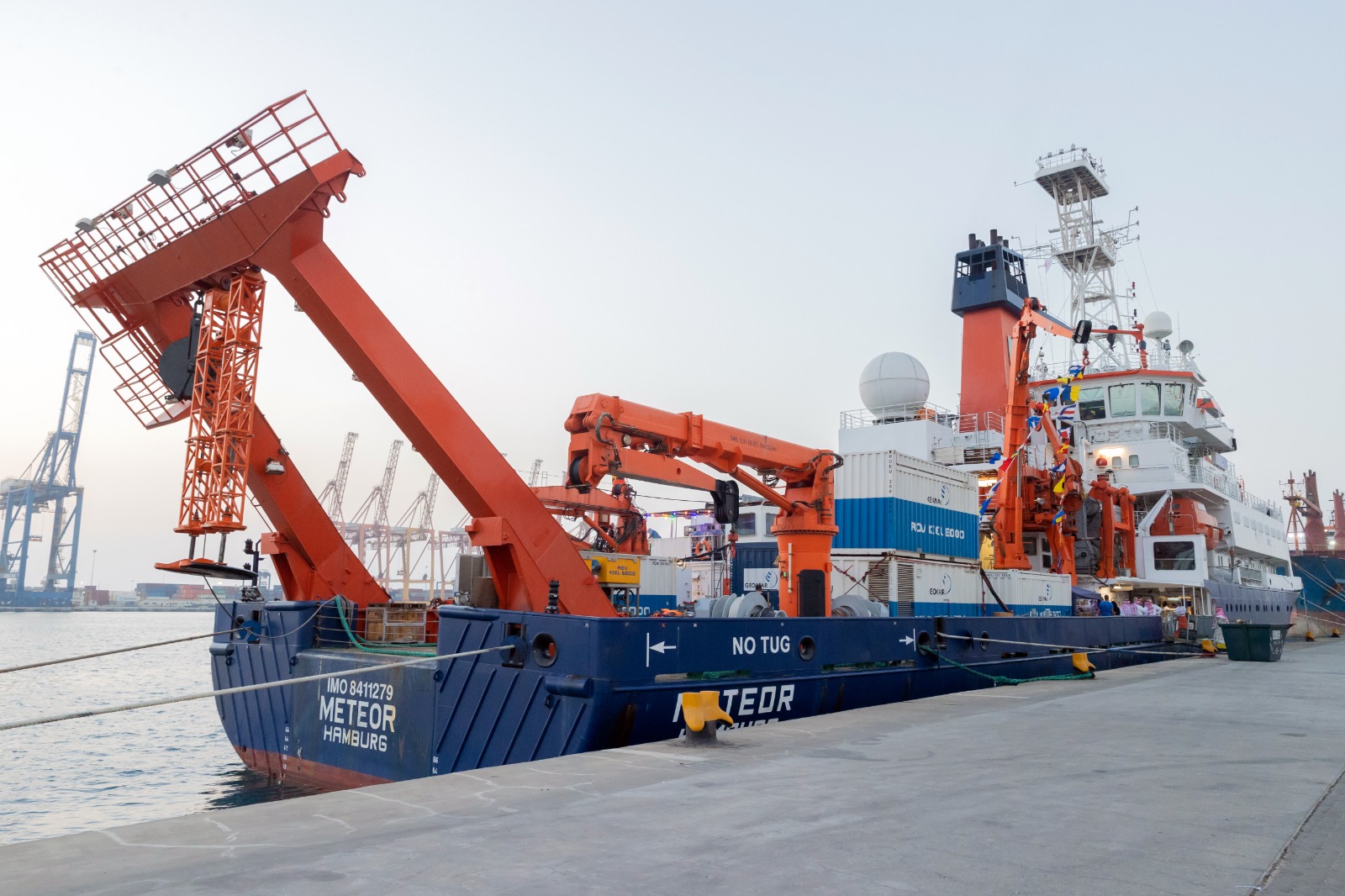GEOMAR and KAUST begin collaborative expedition to unveil Red Sea's hydrothermal vents

KAUST scientists and collaborators in front of the Meteor in Jeddah.
In a collaborative effort between King Abdullah University of Science and Technology (KAUST) and GEOMAR Helmholtz Centre for Ocean Research Kiel, a major research expedition took place in the Red Sea aboard the nearly 100-meter-long R/V Meteor, one of Germany's prominent research vessels, in October.
This expedition constituted the second of two R/V Meteor cruises; the first cruise (expedition, M193 REPLENISH) was led by Dr. Thomas Lüdmann, a scientist at the University of Hamburg, and Dr. Hildegard Westphal, a professor at ZMT Bremen and visiting faculty at KAUST, and focuses on studying the Al Wajh coral reefs and surroundings areas. R/V Meteor departed from Limassol, Cyprus on September 8, 2023, and arrived at the Jeddah Islamic Port October 4.
"We are investigating the history of life in the Red Sea during the dramatically changing conditions of the last few hundred thousand years wiping out large portions of marine life. During the interglacial period, life came back and flourished under conditions that in some cases were warmer than today. Reconstructing those changes helps to understand how ecosystem resilience evolves, and how recolonization after harsh times takes place,” said Westphal about REPLENISH.
In between the expeditions, a reception took place aboard the ship at Jeddah port on Sunday, October 8 following the conclusion of the first expedition. Various representatives attended the reception, including those from KAUST, the Jeddah Islamic Port, Red Sea Global, National Center for Wildlife, and the German embassy. The second expedition (M194 HEXPLORES) departed on October 10, 2023, and expected to arrive in Piraeus, Greece on November 7, 2023. HEXPLORES is led by Chief Scientist Dr. Nico Augustin from GEOMAR Helmholtz Centre for Ocean Research Kiel and Dr. Froukje van der Zwan, Assistant Professor of the KAUST Earth Science and Engineering, Physical Science and Engineering and Associate Director of the Red Sea Research Center.
KAUST’s president, Tony Chan said the Red Sea Research Center plays a vital role, both in spearheading studies of the Red Sea and drawing global experts to KAUST and the Kingdom.
“These two R/V Meteor cruises are an excellent example of such a collaboration. The combined expertise of the different institutions from Germany and the Kingdom, the multiple involved disciplines such as geology, oceanography, and biology,” he said. “And the capacities of a ship like the Meteor allows us to study the treasures in the azure waters of the Red Sea and to discover its mysteries and unknown depths.”

Meteor at the dock.
M194 HEXPLORES is conducting research along the volcanic axis of the deep Red Sea, with the primary goal of locating so far undiscovered black smoker hydrothermal vent fields in the region.
Black smoker hydrothermal vent fields, van der Zwan explained, occur in all deep oceans and possess a unique fauna that survive through chemosynthesis and not photosynthesis – the primary form of producing energy by most life –as there is no sunlight available at these depths.
“These species are a little different in every ocean, and the Red Sea is environmentally quite different than other oceans – its deep water is warmer and saltier and the Red Sea is a relatively closed and young environment.” said van der Zwan.
“We, therefore, expect to find new species either in the macrofauna or in the microbes, and we can learn about evolution of these systems and therefore early life on Earth.” she continued.
Further, she added, the microbes that thrive in the unique environment of black smokers may have unusual biological and metabolic properties. These properties could be the basis for new technologies in medicine, waste disposal, and carbon sequestration. Black smokers may also be a source for valuable metals like copper, zinc, lead, gold, and silver. However, locating and fully understanding active hydrothermal vents in the Red Sea and studying their geological processes, habitats and ecosystems in detail is crucial to provide guidelines for any potential commercial activities.
The partnership reflects how science of the Red Sea benefits from bringing together top expertise and high-tech equipment from a multinational collaboration.
“The strength of this expedition will be our combined expertise. In this case, GEOMAR’s expertise in the deep sea and hydrothermal vent field research and KAUST’s regional and specialized knowledge about the Red Sea. This expedition can only happen by combining expertise of different institutes, but also of different disciplines within both institutes, such as geology, microbiology, zoology, oceanography, and fluids chemistry,” said van der Zwan.
"After nearly a decade of preparations and groundwork together with KAUST, we are thrilled to finally set sails to the most promising target areas in the Red Sea rift. We are very optimistic to discover new hydrothermal systems and look forward to what we find, especially the unique ecosystems. Will they resemble anything we have seen before, or will they be entirely novel? That is the beauty of deep-sea research - we are the first to witness the mysteries of the deep Red Sea, " said Augustin.

